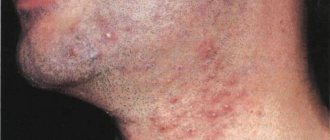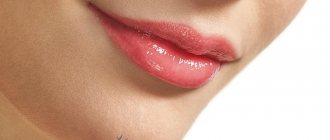What it is
Double bubble – translated from English means double breasts. In the first paragraph it was stated that this is a specific complication, so the following definition can be given.
This is a complication after breast augmentation using low-quality implants, resulting in breast deformation in the form of a double fold or double bubble.
Double bubble after mammoplasty is a general surgical complication and quite rarely develops after breast surgery.
Photo: Double breast
A double fold is a breast deformation that occurs after breast replacement when the implant and bust cannot form a single whole and, as a result, the implant acts as an additional roundness.
Double fold correction methods
Correction of an early defect comes down to repeat mammoplasty. To eliminate the late variant, there are several correction methods, but all of them are also surgical with a greater or lesser degree of invasiveness.
If the cause of the formation of a double bubble is mammary fibrosis, it is enough to perform a capsulotomy. The prosthesis is not removed or changed, but is returned to its normal position and shape.
If the cause of the defect is tubular breast, repeated plastic surgery with replacement of the endoprosthesis will be necessary. It is preferable to choose inserts with an ultra-high profile with a truncated base:
- for tube-breast reconstruction;
- women with cone-shaped breasts;
- and for patients with a normally developed bust, but with a reduced lower part of the chest with a high inframammary fold.
During the operation, it is necessary to form a fold below the natural one and adapt the gland tissue to the prosthesis.
With this we say goodbye to you. We hope that our information was useful to you and that you received the answer you were looking for. Read our new articles and invite friends via social networks.
A double fold after mammoplasty is one of the undesirable side effects that occurs infrequently, but negates the results of the operation.
This defect requires repeated surgical correction; there is no other way to correct it.
Features of the female breast
The mammary gland is a paired organ that consists of glandular tissue.
The mammary gland consists of the following components:
- glandular lobules, which consist of adipose and connective tissue;
- nipple - a pigmented, rough formation, the color of which can have different shades;
- areola, which can also be of different shapes;
The mammary gland is covered with smooth skin. Under the skin there is a fat layer. Under the fat layer is the body of the mammary gland, which is covered with a connective capsule.
In turn, the connecting capsule is suspended on the collarbone. The chest is located at the second and third level of the ribs.
The nipple and areola are approximately located at the level of the fifth and sixth ribs. The inframammary fold is located at the level of the seventh and eighth ribs.
The body of the mammary gland is located in a connecting sheath, which is formed from the superficial fascia. The fascia divides into two plates that surround the gland.
Photo: Mammary gland
A large number of connective tissue “Cooper’s ligaments” are directed from the anterior surface of the mammary gland to the deep layers of the skin, which maintain the shape and structure of the mammary gland.
Between the posterior surface of the fascia and the pectoral muscle there is a loose layer of fatty tissue that tightly covers the body of the mammary gland.
What does the double bubble look like after mammoplasty?
As already mentioned, a double bubble means the appearance of a double fold on the chest.
Depending on the deformation of the breast, it may have a different appearance.
But at the same time, there is always an aesthetic aspect, which, in any type of double fold, makes the breasts ugly, deformed and, of course, requiring surgical intervention to correct this complication.
This complication may look like this:
- breasts are superimposed on one another;
- an implant located in the chest can act as an additional roundness;
- the breast may look as if the mammary gland is flowing down the implant, while the nipple and areola are lowered down; experts call this type of complication the “waterfall effect.”
This complication is characterized by deformation of the mammary gland, when a double fold is formed after installation of the implant.
The prosthesis looks like additional roundness. This has the appearance of a bifurcated mammary gland or double bladder. This complication ranges from 30% of all breast augmentation operations performed.
Types of mammoplasty, photo
When talking about mammoplasty, many ladies mean exclusively breast augmentation. It just so happens that a significant part of women are dissatisfied with the volume of their décolleté and hope to change it to a greater extent. However, there are other types of interventions in the mammary gland that are also in demand today:
- Mastopexy
– lifting sagging breasts. It can be combined with the installation of prostheses or done independently. In fact, during the operation, excess skin and fatty tissue are simply removed. - Augmentation mammoplasty
is a traditional and widely popular breast augmentation using prosthetics. - Reduction mammoplasty
is a rarer, usually performed for medical reasons, breast reduction. Using liposuction, the surgeon removes all unnecessary fat, glandular tissue, and so on. - Aesthetic correction of the nipple-areolar complex
. It is possible to reduce the size of the areola (pigmented circle) or restore the appearance of the nipples after other operations.
Now you know all the popular types of interventions with a plastic surgeon’s scalpel. I suggest you look at a series of photos - through which famous movie and show business stars passed.
If you decide to have surgery, you are interested in many of the nuances that are shown in the video: how a consultation with a plastic surgeon takes place, the course of the operation itself and its result after rehabilitation. For those over +18
- follow the link to YouTube and you can watch it there.
Photo: Before and after surgery
Causes
A double bubble can occur for several reasons, and this complication is also associated with the technique of breast surgery.
The main reason for the appearance of a double bubble after plastic surgery is a reduced, underdeveloped lower pole of the mammary glands.
In this case, the main part of the glandular tissue is located in the upper pole of the mammary gland.
At risk are patients with:
- tubular;
- cone-shaped;
- or a normally formed mammary gland;
- but at the same time with exaggerated inframammary folds.
This reason for the appearance refers to the early appearance of a double fold.
The tubular breast shape has an excessively narrow base and large areolas in diameter, and the inframammary fold is too high. With this form, the glandular tissue is concentrated in the upper pole and has a tube structure.
Cone-shaped is a shape in which the breast is three to four times wider than the nipple-areolar complex of the breast, while the shape of the mammary gland has the appearance of a pyramid.
The main reasons associated with the appearance of the late “double bubble” effect are as follows:
- mammary fibrosis;
- gland sliding off the implant or “waterfall” effect;
- lowering the implant below the formed fold.
With mammary fibrosis, the capsule contracts, the prosthesis contracts, and the soft tissue of the mammary gland rises to the top, while the implant itself moves down.
Reasons for the late appearance of the double bubble
Late manifestations include the formation of deformity 1-2 years after augmentation. But, unfortunately, patients of plastic surgeons are not guaranteed against the appearance of a double bubble even 5-10 years after the installation of an endoprosthesis.
The reasons for this development of events are considered, firstly, to be injuries and careless attitude towards the new breast. As a result, the iron literally “crawls” along the implant, “a waterfall effect is formed”:
- the SAC area (areola + nipple) loses its shape and falls significantly below its intended place;
- the prosthesis moves downwards and forms an unsightly additional protrusion.
Secondly, the defect often results from the formation of a fibrous capsule. The fibrous tissues that have formed around the implant put a lot of pressure on it, “squeezing” it down. The prosthesis will shift to where there is less resistance and form an unsightly bump. This is the most likely cause of the defect in later stages.
Thirdly, this effect is possible if the prosthesis falls below the inframammary fold artificially formed by the surgeon.
What to do
To eliminate this defect, additional surgical intervention is necessary, in which it is necessary to excise the breast tissue, straighten it and form a fold in a new place.
The operation of correcting a double bladder is, on the one hand, very simple, but on the other hand, it requires care and respect for the mammary gland.
What is difficult about this operation is that you need to carefully straighten the breast tissue in order to fix it correctly and form a submammary fold in a new place to obtain an aesthetically beautiful result.
The main goal of the operation is to move the inframammary fold down to the correct position. First, a skin incision is made, the gland tissue is released, isolated from both sides, then the gland is dissected.
After straightening and unfolding the folds of tissue, the gland is sutured to a new submammary fold. As a result, the deformation is eliminated, and the submammary folds become smooth and symmetrical.
Also, when correcting a double fold, the following manipulations can be performed :
- capsulotomy;
- removal of the prosthesis;
- installation of a new prosthesis;
- breast lipolift.
This complication may be preceded by complications in the form of capsular contracture - the formation of a thick fibrous capsule, which seems to squeeze out the implant and, as a result, a “double bubble” effect is formed.
To do this, the plastic surgeon performs a capsulotomy process, excising the excess fibrous compaction around the implant.
Sometimes the process of removing the implant becomes inevitable. This happens mainly due to the individual characteristics of the patient’s body, for example, a caused allergy to the material from which the prosthesis is made.
As a result of such an allergic reaction, swelling of the breast tissue occurs and with such swelling the implant is compressed and the breast is deformed and it looks like a double bubble.
In this case, it is necessary to immediately remove the implant, since the caused allergy threatens not only the aesthetic appearance, but also the health of the patient.
Also, if low-quality prostheses were chosen when choosing an implant, they also need to be removed, because the breasts will be constantly deformed and the woman will not feel beautiful and confident.
Photo: Breast lipolift
Breast lipolifting is one of the most popular solutions for eliminating double folds and even breast enlargement, without the use of implants.
This operation is performed by transplanting the patient’s own adipose tissue from places where there is a lot of it.
When performing breast correction using lipolifting, fat is injected into the anatomical area of the breast and the specialist who performs this procedure can correct and create an individual breast shape in each case separately.
In order to avoid a double fold, a combined installation of the implant is needed, or in other words, the formation of a two-plane bed for it.
With this process, the upper part of the implant is installed under the pectoralis major muscle, while pressure is exerted on it from top to bottom and with this arrangement the prosthesis is in a straightened state and has a constant shape, which allows the formation of a normal lower pole of the mammary gland.
If the prosthesis is completely under the muscle, including the lower pole, then due to this work of the lower muscles, the implant is squeezed upward and the “double bubble” effect is obtained..
Methods of prevention Speaking about methods of prevention can be divided into three stages.
The first stage includes all the actions that are carried out before the operation itself regarding breast plastic surgery, these include:
- choosing a plastic surgeon;
- passing all necessary tests;
- compliance with all recommendations of the plastic surgeon;
- choosing a clinic;
Find out what contracture is after mammoplasty.
When are sutures removed after blepharoplasty? Read the article.
The second stage is directly related to the operation itself and there must be correct manipulations by the plastic surgeon himself.
These include:
- correct anesthesia ratio;
- choosing the location of the implant;
- correct application of the necessary cuts;
- suture technique;
The third stage of preventing the “double bubble” complication, in which all responsibility falls on the patient’s shoulders, since this is a rehabilitation period in which the patient must behave responsibly in relation to her health and the aesthetic appearance of her figure.
During the rehabilitation period, the following recommendations should be followed:
- wearing compression garments;
- limiting physical activity;
- compliance with the recommendations of the attending physician;











